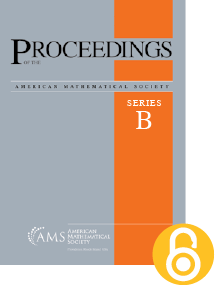Volume of the Minkowski sums of star-shaped sets
HTML articles powered by AMS MathViewer
- by Matthieu Fradelizi, Zsolt Lángi and Artem Zvavitch HTML | PDF
- Proc. Amer. Math. Soc. Ser. B 9 (2022), 358-372
Abstract:
For a compact set $A \subset \mathbb {R}^d$ and an integer $k\ge 1$, let us denote by \begin{equation*} A[k] = \left \{a_1+\cdots +a_k: a_1, \ldots , a_k\in A\right \}=\sum _{i=1}^k A \end{equation*} the Minkowski sum of $k$ copies of $A$. A theorem of Shapley, Folkmann and Starr (1969) states that $\frac {1}{k}A[k]$ converges to the convex hull of $A$ in Hausdorff distance as $k$ tends to infinity. Bobkov, Madiman and Wang [Concentration, functional inequalities and isoperimetry, Amer. Math. Soc., Providence, RI, 2011] conjectured that the volume of $\frac {1}{k}A[k]$ is nondecreasing in $k$, or in other words, in terms of the volume deficit between the convex hull of $A$ and $\frac {1}{k}A[k]$, this convergence is monotone. It was proved by Fradelizi, Madiman, Marsiglietti and Zvavitch [C. R. Math. Acad. Sci. Paris 354 (2016), pp. 185–189] that this conjecture holds true if $d=1$ but fails for any $d \geq 12$. In this paper we show that the conjecture is true for any star-shaped set $A \subset \mathbb {R}^d$ for $d=2$ and $d=3$ and also for arbitrary dimensions $d \ge 4$ under the condition $k \ge (d-1)(d-2)$. In addition, we investigate the conjecture for connected sets and present a counterexample to a generalization of the conjecture to the Minkowski sum of possibly distinct sets in $\mathbb {R}^d$, for any $d \geq 7$.References
- Sergey Bobkov, Mokshay Madiman, and Liyao Wang, Fractional generalizations of Young and Brunn-Minkowski inequalities, Concentration, functional inequalities and isoperimetry, Contemp. Math., vol. 545, Amer. Math. Soc., Providence, RI, 2011, pp. 35–53. MR 2858464, DOI 10.1090/conm/545/10763
- W. R. Emerson and F. P. Greenleaf, Asymptotic behavior of products $C^{p}=C+\cdots +C$ in locally compact abelian groups, Trans. Amer. Math. Soc. 145 (1969), 171–204. MR 249535, DOI 10.1090/S0002-9947-1969-0249535-2
- Matthieu Fradelizi, Mokshay Madiman, Arnaud Marsiglietti, and Artem Zvavitch, Do Minkowski averages get progressively more convex?, C. R. Math. Acad. Sci. Paris 354 (2016), no. 2, 185–189 (English, with English and French summaries). MR 3456896, DOI 10.1016/j.crma.2015.12.005
- Matthieu Fradelizi, Mokshay Madiman, Arnaud Marsiglietti, and Artem Zvavitch, The convexification effect of Minkowski summation, EMS Surv. Math. Sci. 5 (2018), no. 1-2, 1–64. MR 3880220, DOI 10.4171/EMSS/26
- Matthieu Fradelizi and Arnaud Marsiglietti, On the analogue of the concavity of entropy power in the Brunn-Minkowski theory, Adv. in Appl. Math. 57 (2014), 1–20. MR 3206519, DOI 10.1016/j.aam.2014.02.004
- Katalin Gyarmati, Máté Matolcsi, and Imre Z. Ruzsa, A superadditivity and submultiplicativity property for cardinalities of sumsets, Combinatorica 30 (2010), no. 2, 163–174. MR 2676833, DOI 10.1007/s00493-010-2413-6
- Rolf Schneider, Convex bodies: the Brunn-Minkowski theory, Second expanded edition, Encyclopedia of Mathematics and its Applications, vol. 151, Cambridge University Press, Cambridge, 2014. MR 3155183
- R. M. Starr, Quasi-equilibria in markets with non-convex preferences, Econometrica 37 (1969), no. 1, 25–38.
- Ross M. Starr, Approximation of points of convex hull of a sum of sets by points of the sum: an elementary approach, J. Econom. Theory 25 (1981), no. 2, 314–317. MR 640201, DOI 10.1016/0022-0531(81)90010-7
Additional Information
- Matthieu Fradelizi
- Affiliation: LAMA, Univ Gustave Eiffel, Univ Paris Est Creteil, CNRS, F-77447 Marne-la-Vallée, France
- MR Author ID: 626525
- Email: matthieu.fradelizi@u-pem.fr
- Zsolt Lángi
- Affiliation: Morphodynamics Research Group and Department of Geometry, Budapest University of Technology, Egry József utca 1, Budapest 1111, Hungary
- Email: zlangi@math.bme.hu
- Artem Zvavitch
- Affiliation: Department of Mathematical Sciences, Kent State University, Kent, Ohio 44242
- MR Author ID: 671170
- ORCID: 0000-0001-6347-5386
- Email: zvavitch@math.kent.edu
- Received by editor(s): October 14, 2019
- Received by editor(s) in revised form: July 12, 2021
- Published electronically: August 29, 2022
- Additional Notes: The first author was supported in part by the Agence Nationale de la Recherche, projet ASPAG - ANR-17-CE40-0017; the second author was partially supported by the National Research, Development and Innovation Office, NKFI, K-119670, the János Bolyai Research Scholarship of the Hungarian Academy of Sciences, and grants BME FIKP-VÍZ and ÚNKP-19-4 New National Excellence Program by the Ministry of Innovation and Technology; the third author was supported in part by the U.S. National Science Foundation Grant DMS-1101636 and the Bézout Labex funded by ANR, reference ANR-10-LABX-58.
- Communicated by: Deane Yang
- © Copyright 2022 by the authors under Creative Commons Attribution-NonCommercial 3.0 License (CC BY NC 3.0)
- Journal: Proc. Amer. Math. Soc. Ser. B 9 (2022), 358-372
- MSC (2020): Primary 52A40; Secondary 52A38, 60E15
- DOI: https://doi.org/10.1090/bproc/97
- MathSciNet review: 4474695


